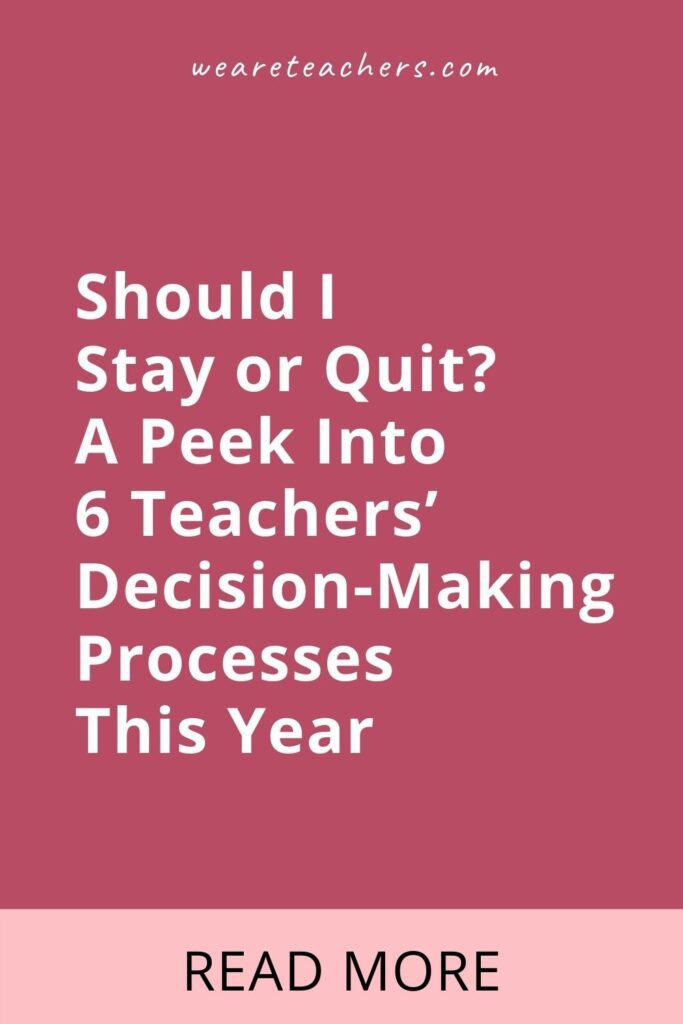The pandemic took an exceptional toll on educators, and now the data is showing just how severe it was. After more than two years of virtual teaching, masking, and trying to fill the pandemic-created education gap, some teachers are calling it quits. For some, it was a decision they started contemplating even before the pandemic. For others, it ended up being a motivator to dig even deeper into their role to find a new passion for it.
A February 2022 National Education Association survey alerted Americans to just how dire the teacher shortage might become—55 percent of educators were thinking of leaving, a significant increase from 37 percent the previous August. The survey pointed to pandemic-related stress, which 91 percent said was a serious problem for educators, causing 90 percent of them to say burnout is a “serious” problem and 67 percent to label it a “very serious” problem. Here are some of their stories, from those who left the profession as well as those who just thought about it.
Catherine Aulicino, a 5-year veteran science teacher of 9th- and 10th-grade science
Aulicino recently quit teaching after feeling a “sense of dissolution” when she became a teacher in Ohio.
“We don’t go into teaching for the money and fame, but I felt such a sense of dissolution when I became a teacher. The education system was built on unpaid teacher hours. I can’t think of another industry where that is the case (on a government-funded level). I was shocked by the lack of resources, classrooms, funding, support—and I worked for a good district.”
But what she said finally made her decide to leave was sharing a room with an art teacher as a science teacher needing to do labs.
“I teach high school science—[with] no safety shower, sinks, outlets, Bunsen burners, counter space, lab equipment, or time to tear down/set up labs because art would start right after my classes and I had to travel during my plan bell. It was a logistical nightmare and made it impossible to do my job the right way.”
Takshi Chopra, an 11-year veteran teacher of middle school science
Chopra’s experience shows the educator shortage epidemic is not just a U.S. dilemma—she taught in Ghaziabad, UP, India. “The profession is considered noble for a reason—because teachers are impactful. In my case, I think I was done being monitored by the amount of impact I can make.” So, after 11 years, she quit teaching, though she loved being around the kids and says she was “fueled” by their joy and excitement for learning.
“A strictly laid-out instructional lesson plan, what you do, how you do it, looks extremely good on paper but in front of the students, we have to improvise. When the management started putting their opinion in every decision of what I did in my classroom with my kids, even when I am meeting their grasping/learning needs—that was the beginning of it.”
For her, the “final nail in the coffin” was when teachers were asked to work for reduced pay, while they’d already doubled their shifts and ignored their and their families’ health—an ask that she says hasn’t been “embraced” by educators. She made her decision under the firm belief that her employer can replace her anytime, though she gave everything to them “day and night, in sickness and health.” She says her stress levels and health have already improved since making her decision.
But she also says, “I miss my kids. I miss the energy that I was surrounded with. Once a teacher, always a teacher.”
Stephanie Sims, a 5-year special education teacher who ran a multiple-disabilities unit
Ohio-based teacher Stephanie Sims quit teaching just before the pandemic began and says she was so glad to avoid that “dumpster fire” that was virtual teaching, with its many restrictions and additional issues. She taught middle school in an urban setting. When she had her third baby, and her initial class had moved up through graduation, she says she “ran out of there as fast as she possibly could.”
For her, the reason was never the students, whom she loved, or even the parents, whom she calls supportive. “I had to spend so much time proving that I was a good teacher that I couldn’t actually be a good teacher.” This was because she was a part of RESA, Ohio’s Resident Educator Program that lasted at least four years and required multi-layered tasks, videos, and proof of competency in the classroom that she found unrealistic to the daily happenings in a “real” classroom with actual children. “You had to portray a perfectly manicured classroom.”
Sims explains that the education system isn’t set up to account for the many basic needs that aren’t met for students before they are required to learn, including showers, food, and a safe home, all of which are transferred into the classroom. “There’s just so much reform that needs to happen.” She now runs a financial-planning blog, focusing on mothers, and says she is still teaching in that form, just with a different type of student.
Anita*, a 5-year veteran high school science teacher
“Last year was completely miserable for me. I went in with high hopes that things would be back to normal after the 2019-20 and 2020-21 years both being tough. But it wasn’t normal,” says Anita*, whose name has been changed for privacy and who teaches in Wisconsin. “I was still dealing with leftover burnout from the last few years. And getting used to teaching in person again was hard on me.”
But the stress wasn’t enough to actually quit. “Even when things are impossible, my students put a smile on my face. They’re the light of my life. And I knew my rising seniors next year from back when they were freshmen, so I knew I wanted to stay for them.” She calls it an “agonizing” decision as both her head and body were saying she needed a break. “My heart was saying to keep fighting.”
She says she realized it wouldn’t be fair to try to pour from an empty cup, so she moved to the role of science paraprofessional, to stay around the kids but without the “lesson planning and grading responsibilities that were mentally killing me last year.”
“I’m very thankful that admin at my school was not only receptive to this but thrilled that they can keep me in this role. I’m also very happy that I’m financially secure enough to take this step. I’m hoping to teach full-time again in a few years. I see this as a ‘see you later’ to full-time teaching, not a ‘goodbye’ to it.”
Sam*, a middle and high school English language arts teacher with 11 years of experience
Ohio English teacher Sam*, whose name has been changed for privacy, considered quitting many times during the pandemic.
“My commute is overwhelming. So many jobs moved to the hybrid model or to the work-from-home model, but my job doesn’t offer either despite them promising virtual options. It’s especially tricky not to have work-from-home options when childcare facilities shut down or illness runs rampant,” she says. “I decided to tough it out in the education field because I admire and enjoy the other teachers in my building, because I have a good reputation in my district, and because I have a solid co-teacher that I can depend on. It’s the relationships that kept me in my career field.”
During one pandemic month alone, she ended up paying $3,000 in childcare expenses for one toddler, as her day-care center closed but she had to continue paying while seeking additional care. “I am nervous about this year but a bit optimistic because rules are loosening.”
Liz Oppelt, a 9-year high school theater and social studies teacher
Oppelt stayed with teaching in spite of considering a career change because she feels like she’s “making a difference at the most basic level—I work with students and I help them as individuals.” She says that no other career would have that same specific impact.
“There are students I currently work with and specific groups of students I work with that I am not sure would have someone else if I left. So many of the teachers I work with that I loved and trusted are gone. I don’t know who would be left to protect my kids. We are losing so many good teachers, and I don’t blame them for leaving. But I worry about what is left when they all leave.”
She also says the financial burden of having to further her education to switch career paths is limiting.
It remains to be seen what will happen with the country’s—and the world’s—severe teacher shortage. Many predict it will continue to get worse until systematic reform, such as increased pay, less focus on test scores, and additional measures, takes place. Until these changes are made, teachers and administrators will suffer, and unfortunately, so will the kids.
What are your thoughts on educators leaving the profession? Please share in the comments.
To find out about more content like this, be sure to sign up for our free newsletters.


